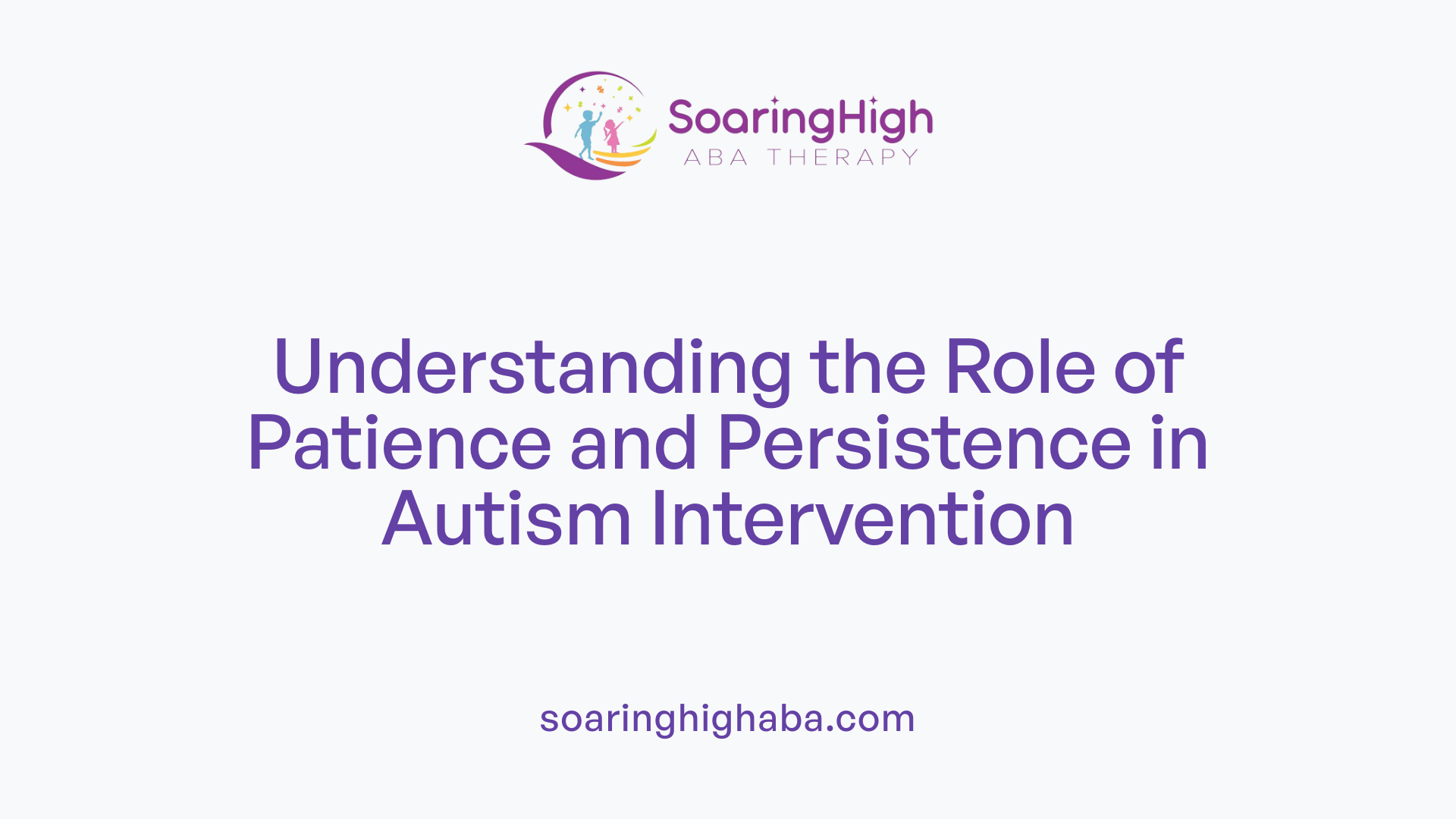Understanding the Cornerstones of Effective ABA Therapy
ABA therapy is recognized as the gold standard in autism treatment, emphasizing a structured yet flexible approach tailored to individual needs. Central to the success of ABA interventions are the qualities of patience and persistence, which underpin effective implementation, foster meaningful progress, and support long-term positive outcomes. This article explores how these essential traits influence therapy efficacy, strategies to nurture them, and their significance for both caregivers and therapists.
Core Qualities Driving Successful ABA Interventions

What are the fundamental qualities essential for successful ABA interventions?
Successful Applied Behavior Analysis (ABA) therapy depends on a set of core qualities that ensure effective and compassionate treatment. These qualities include patience, persistence, and consistency. Patience allows therapists and parents to stay calm and supportive, especially when progress is slow or behaviors are challenging. Persistence is crucial for maintaining focus and continuously working toward achievable goals despite setbacks or difficulties.
Empathy and cultural sensitivity are vital in understanding each child's unique background, experiences, and needs. These qualities foster trust and a stronger connection, making therapy sessions more effective and engaging. Effective communication skills—such as active listening, clear instructions, and accurate data collection—are necessary for assessing progress and adjusting interventions in real-time.
Adaptability, creativity, and critical thinking enable therapists to modify strategies tailored to each child's evolving needs. This flexibility promotes skill generalization across different environments and reduces frustration. Collaboration with families through ongoing education and support helps maintain consistency outside therapy sessions, which accelerates progress.
Furthermore, a positive, safe, and supportive environment enhances learning. Continuous professional development and a commitment to evidence-based practices are also essential for maintaining high-quality care and achieving lasting improvements.
| Qualities | Description | Impact on Therapy |
|---|---|---|
| Patience | Staying calm and supportive during slow progress or setbacks | Builds trust, reduces anxiety, encourages perseverance |
| Persistence | Continued effort despite challenges | Ensures steady progress and skill acquisition |
| Consistency | Following structured routines and reinforcement uniformly | Reinforces learning and promotes behavior stability |
| Empathy | Understanding individual backgrounds and emotional states | Fosters trust and motivation |
| Cultural Sensitivity | Respecting and adapting to cultural differences | Creates inclusive, personalized care |
| Effective Communication | Active listening, clear instructions, accurate data collection | Tailors interventions and monitors progress effectively |
| Flexibility & Creativity | Adapting methods to fit individual needs | Enhances engagement and promotes skill transfer |
| Collaboration | Working with families and interdisciplinary teams | Ensures consistency and comprehensive care |
In summary, the combination of these qualities ensures that ABA therapy is not only effective but also compassionate and personalized. Their integration enables therapists to foster a supportive environment for children with autism to learn, grow, and thrive.
Fostering Patience and Persistence in Therapy and Caregiving

What strategies can be used to foster patience and persistence in ABA treatment?
Building patience and persistence is fundamental in supporting children with autism through ABA therapy. One effective approach is setting realistic goals, which helps avoid frustration and promotes steady progress. Celebrating small achievements also boosts confidence—for both children and caregivers—and encourages continued effort.
Incorporating the concept of ‘The Power of Yet’ is another useful strategy. This mindset emphasizes that skills can develop over time with effort, helping children view challenges as opportunities to grow rather than insurmountable obstacles.
Calming techniques like Breathe, Think, Do, promote self-regulation by teaching children to recognize their emotions and take steps to manage frustration. Such tools empower children to remain patient during learning tasks.
Embracing mistakes as learning opportunities is vital; it fosters resilience and teaches children that setbacks are a natural part of learning, not failure. For caregivers, parent training programs are valuable—they promote consistent application of ABA principles, active participation, and clear communication, which are crucial for the generalization of skills.
Overall, these strategies create a supportive environment where patience and persistence are nurtured, leading to more effective therapy outcomes and helps children develop resilience that benefits all areas of life.
The Impact of Patience and Persistence on Positive Outcomes
 Research indicates that patience and enduring commitment are vital elements in successful ABA therapy for children with autism. Multiple studies demonstrate that continued, consistent efforts lead to notable improvements in critical developmental areas. Meta-analyses reveal that children who receive longer and more intensive intervention tend to show greater gains in receptive language, adaptive behaviors, and cognitive skills.
Research indicates that patience and enduring commitment are vital elements in successful ABA therapy for children with autism. Multiple studies demonstrate that continued, consistent efforts lead to notable improvements in critical developmental areas. Meta-analyses reveal that children who receive longer and more intensive intervention tend to show greater gains in receptive language, adaptive behaviors, and cognitive skills.
The importance of early and sustained intervention cannot be overstated. Approaches like the Early Start Denver Model (ESDM), which combine structured techniques with a patient, long-term perspective, significantly enhance skill acquisition. These methods emphasize that progress often requires months or even years of dedicated work, highlighting the necessity of persistence.
Consistency plays a crucial role in reducing ASD-related challenges. Regular reinforcement and prolonged intervention efforts foster mastery of new skills and promote the generalization of learned behaviors across different settings. When parents and therapists demonstrate patience and perseverance, children are more likely to develop independence and emotional regulation.
While concerns about trauma or PTSD from ABA therapy exist, current evidence stresses that well-implemented, patient approaches contribute positively to children's development. They emphasize that sustained, thoughtful efforts are key to unlocking children’s potential and achieving meaningful, lasting improvements in their social, communication, and academic skills.
What evidence links patience and persistence to positive results in ABA therapy?
| Evidence Source | Outcomes | Additional Details |
|---|---|---|
| Meta-analyses | Significant gains in language, adaptive behavior, cognition | Longer treatment durations correlate with better results |
| Early intervention studies | Higher skill mastery, reduced ASD persistence | Initiating therapy during early developmental stages enhances long-term outcomes |
| Structured programs like ESDM | Improved toddler social skills, language development | Emphasize patient, iterative learning processes |
| Clinical reports | Importance of continuous monitoring and reinforcement | Consistent effort from caregivers and therapists boosts progress |
In summary, unwavering patience and persistence during ABA therapy are strongly associated with improved developmental trajectories in children with autism. Consistent, long-term efforts, especially when started early, support children in acquiring essential skills and fostering greater independence.
Strategies for Building a Supportive Environment

Why are patience and persistence important for caregivers and therapists supporting children with autism through ABA?
Patience and persistence are fundamental in working with children with autism, especially when using Applied Behavior Analysis (ABA). These qualities create a stable, trusting environment where learning can thrive. Children with autism often need time to understand routines, grasp new skills, and adapt behaviors. A calm, consistent approach from caregivers and therapists helps reduce anxiety and builds confidence.
Being patient allows practitioners to respond thoughtfully to each child's unique needs. It also supports the gradual reinforcement of positive behaviors and skills. Persistence ensures that efforts continue, even if progress seems slow or setbacks occur. This steady commitment encourages children to stay motivated, develop independence, and improve communication.
Overall, patience and persistence foster resilience in families and therapists, which is essential for achieving meaningful, long-lasting developmental gains.
Integrating Visual Aids and Play for Skill Development

How do patience and persistence influence the effectiveness of ABA therapy?
Patience and persistence are vital in ABA therapy because they ensure consistent application of intervention strategies, which is essential for helping children with autism acquire new skills and modify behaviors. When caregivers and therapists remain patient and persistent, they create a stable environment that encourages learning even when progress seems slow or challenging.
Using visual aids, schedules, and play methods, combined with patience, helps children understand routines and tasks better, reducing anxiety and promoting engagement. This consistency builds trust and confidence, making learning more effective.
Personalized, child-centered approaches further enhance engagement by aligning activities with the child's unique interests and learning style. When interventions are tailored, children are more likely to participate actively, which accelerates skill acquisition.
Turning everyday activities into opportunities for learning allows children to practice social, language, and behavioral skills in familiar settings, making the lessons more relevant and easier to generalize across environments. For example, playing a simple game or shared reading session tailored to the child's interests can promote communication and social interaction.
Tailoring interventions based on the child's individual learning style is crucial because it increases motivation and the likelihood of success. Visual learners benefit from schedules and pictures, while kinesthetic learners thrive through hands-on activities.
By combining patience and persistence with personalized strategies and everyday opportunities for skill-building, parents and therapists can significantly improve outcomes in autism therapy. Consistent reinforcement and adaptation foster long-term development in communication, social behavior, and independence.
Embracing a Path for Sustainable Progress
In conclusion, patience and persistence are not just virtues but vital components of effective ABA therapy. They underpin consistent, long-term efforts that lead to meaningful behavioral changes and skill development. By fostering these qualities, caregivers and therapists can create a supportive and resilient environment that promotes confidence, independence, and positive outcomes for children with autism. Through ongoing commitment and adaptive strategies, the impact of ABA can be maximized, paving the way for lasting success and improved quality of life.
References
- The Power of Patience in Parenting - American SPCC
- The Importance of Parent Training in ABA Therapy | Childwise
- Easy ABA Techniques to Use with Your Child
- The Importance of a Customized Approach in ABA Therapy
- What Skills Benefit ABA Therapists: Success in Autism Treatment
- The Importance of Parent Training in ABA Therapy | Childwise
- What is ABA Therapy | Behavioral Framework
- How ABA Therapy Enhances Social Skills?
- Examples of Motivating Operations to Enhance ABA Therapy





































































































